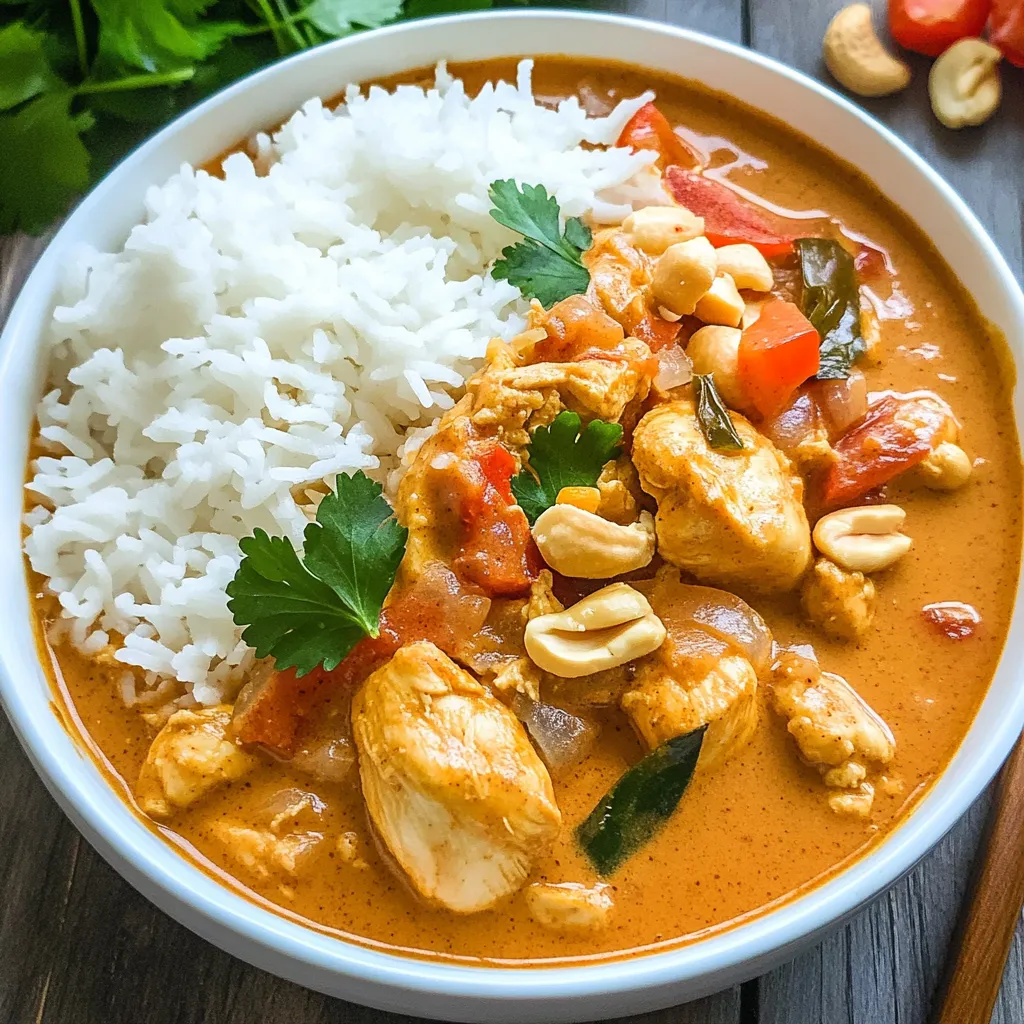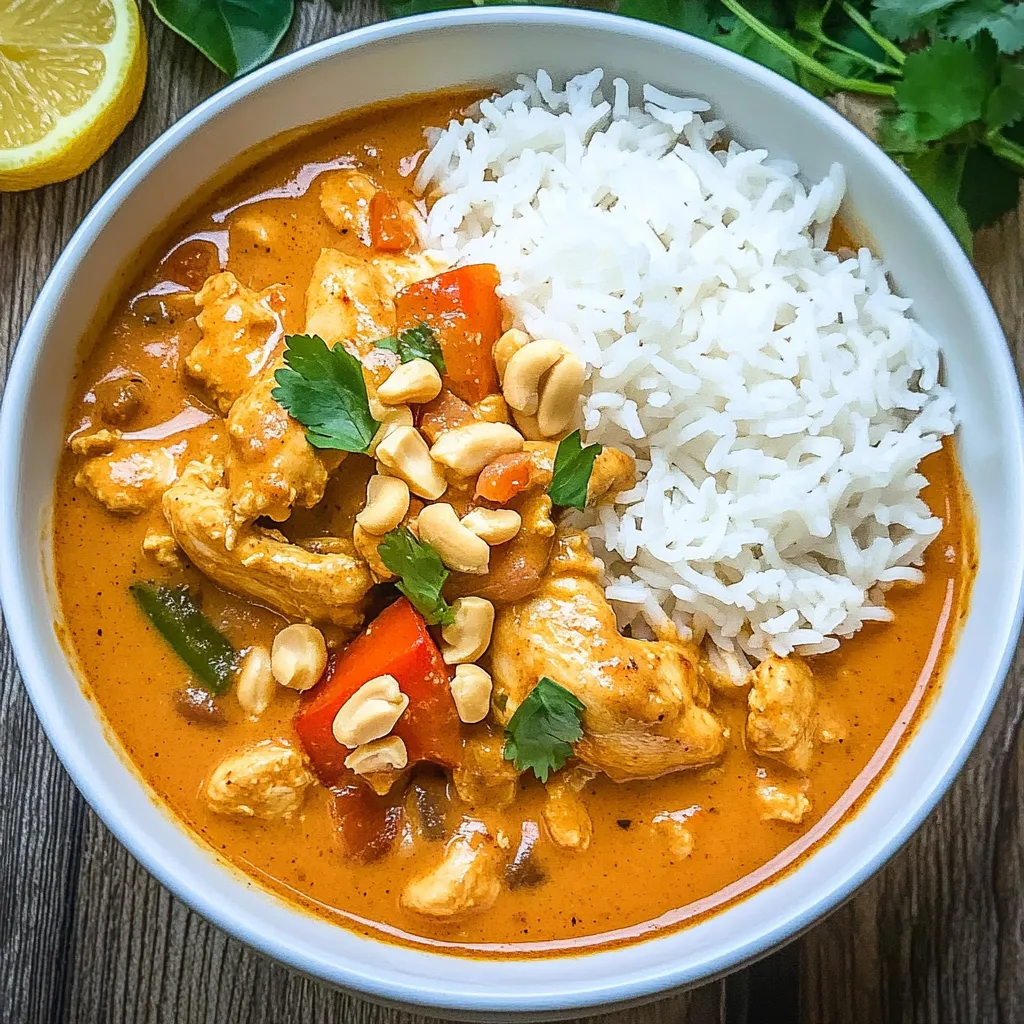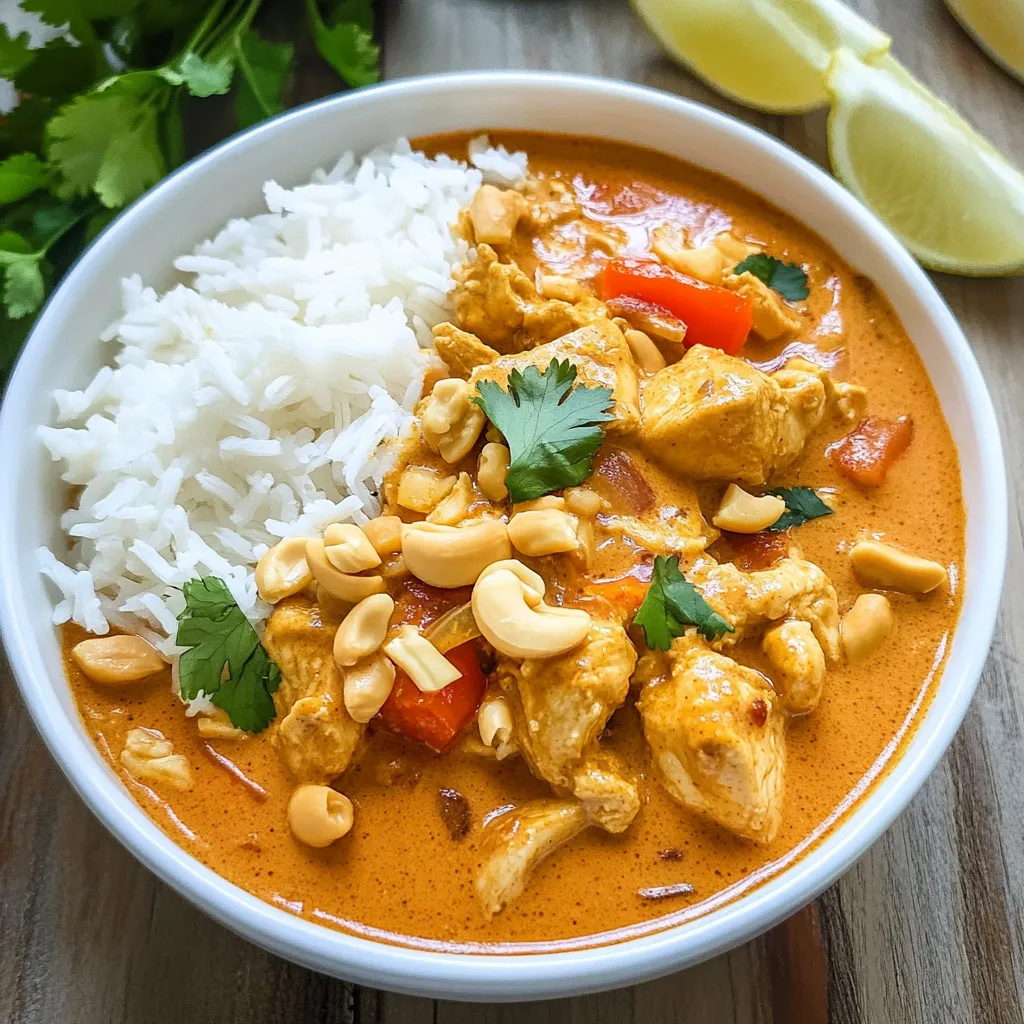 Pin it
Pin it
This Thai peanut curry has become my go-to weeknight dinner when I crave something comforting yet exciting. The creamy peanut sauce balanced with aromatic curry creates a restaurant-quality meal that never fails to impress even the pickiest eaters in my family.
I first made this curry during a particularly rainy weekend when we couldn't go out to our favorite Thai restaurant. My family was skeptical at first, but now they request this dish more than takeout!
Ingredients
- Carrots and potatoes: Provide hearty substance and absorb the flavorful sauce beautifully
- Yellow onion: Creates the aromatic base essential for authentic Thai flavor
- Chicken breast: Adds lean protein, look for free-range for best flavor
- Olive oil: Can be swapped with coconut oil for even more authentic Thai notes
- Ground ginger and minced garlic: Provide warming spice foundation
- Red curry paste: Delivers authentic Thai flavor—the real secret ingredient
- Coconut milk: Creates the silky rich texture, use full-fat for best results
- Peanut butter: Adds signature creaminess, natural works best here
- Brown sugar: Balances the heat with necessary sweetness
- Soy sauce: Provides savory depth, low sodium works perfectly
- Fresh lime juice: Brightens the entire dish and cuts through richness
Step-by-Step Instructions
- Sauté the Vegetables:
- Heat oil in a large skillet over medium-high heat and add diced onions, chopped carrots, and potatoes. Cook for 4-5 minutes until onions become translucent and vegetables begin to soften. This stage builds the foundation of flavor by allowing the vegetables to release their natural sweetness.
- Build the Curry Base:
- Add cubed chicken, ground ginger, minced garlic, and red curry paste. Mix thoroughly to coat the chicken and vegetables with the aromatic spices. The paste should become fragrant within 1-2 minutes, indicating the spices are activating. This step is crucial for developing deep flavor throughout the dish.
- Create the Sauce:
- Pour in coconut milk and reduce heat to medium-low. Allow everything to simmer gently for about 10 minutes, uncovered, stirring occasionally. The sauce will begin to thicken slightly while the carrots and potatoes become fork-tender. This slow simmer allows flavors to meld together beautifully.
- Enrich the Flavor:
- Stir in peanut butter, brown sugar, soy sauce, and fresh lime juice. The peanut butter will initially look separated but will incorporate smoothly with continuous stirring. Continue cooking for another 4-5 minutes until the sauce reaches a velvety consistency and coats the back of a spoon. Taste and adjust seasonings if needed.
- Serve and Garnish:
- Spoon the curry over steamed rice. Jasmine rice works exceptionally well with its subtle floral notes. Sprinkle chopped peanuts on top for a delightful textural contrast and visual appeal. The heat from the curry will slightly toast the peanuts, enhancing their flavor.
 Pin it
Pin it
The red curry paste is truly the heartbeat of this recipe. I once tried making this without it, substituting with dried spices, and the difference was remarkable. The authentic paste contains lemongrass, galangal, and kaffir lime leaves that simply cannot be replicated with basic pantry spices.
Storage Tips
This curry actually improves with time as the flavors continue to develop. Store leftovers in an airtight container in the refrigerator for up to 4 days. When reheating, add a splash of water or coconut milk if the sauce has thickened too much. You might notice the oils from the peanut butter separating when cold, but they will reincorporate when gently reheated.
Vegetarian Adaptation
This curry easily transforms into a vegetarian delight. Simply omit the chicken and double the vegetables, or add firm tofu cubes or chickpeas for protein. For tofu, I recommend pressing it first to remove excess moisture, then lightly frying it separately before adding to the curry. This creates a better texture that holds up well in the sauce. Plant-based protein alternatives like seitan also work wonderfully in this recipe.
Spice Level Adjustments
Thai cuisine is known for its balance of flavors, and heat is an important component. For a milder curry, start with just half the jar of curry paste and add more to taste. For those who enjoy more heat, add a thinly sliced Thai chili with the vegetables, or incorporate a teaspoon of chili garlic sauce when adding the curry paste. Remember that the coconut milk and peanut butter will temper the spice, so it may need more heat than you initially think.
Serving Suggestions
While this curry shines over simple steamed rice, consider stepping up your presentation by serving it alongside cucumber salad dressed with rice vinegar and a touch of sugar. The cool crunch provides a refreshing contrast to the warm, creamy curry. For special occasions, add a side of roti or naan bread for scooping up the sauce. Fresh herbs like cilantro, Thai basil, or even mint make beautiful and flavorful garnishes that elevate the final dish.
 Pin it
Pin it
This Thai peanut curry delivers rich, authentic flavor with simple ingredients, making it a reliable favorite in our household.
Frequently Asked Questions
- → Can I make this Thai peanut curry vegetarian?
Yes! You can easily make this dish vegetarian by substituting the chicken with tofu or additional vegetables like bell peppers, broccoli, or cauliflower. The peanut curry sauce works beautifully with any protein alternative.
- → How spicy is this Thai peanut curry?
The spice level depends on the red curry paste you use. Most store-bought varieties provide a mild to medium heat. You can adjust the spiciness by adding more or less curry paste, or including fresh chilies for extra heat.
- → Can I use a different type of curry paste?
Absolutely! While red curry paste creates the authentic flavor profile, you can substitute yellow or green curry paste for different flavor variations. Each will create a distinctive but equally delicious Thai curry.
- → What can I serve with Thai peanut curry?
Jasmine rice is traditional, but this curry also pairs well with brown rice, rice noodles, or cauliflower rice for a lower-carb option. Fresh cucumber salad or spring rolls make excellent side dishes.
- → Can I make this curry ahead of time?
Yes! This curry actually develops even better flavor when made ahead. Store it in the refrigerator for up to 3 days, or freeze for up to 3 months. The flavors will deepen and meld together beautifully.
- → Is there a substitute for coconut milk?
While coconut milk provides the authentic flavor and creamy texture, you could substitute with heavy cream mixed with a bit of chicken broth. The flavor profile will change somewhat but still remain delicious.
